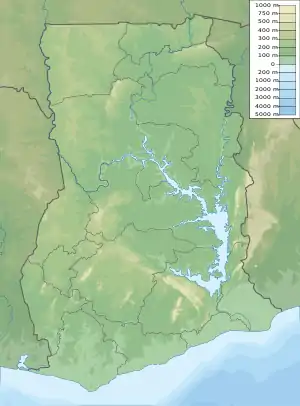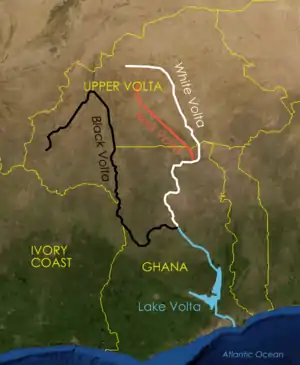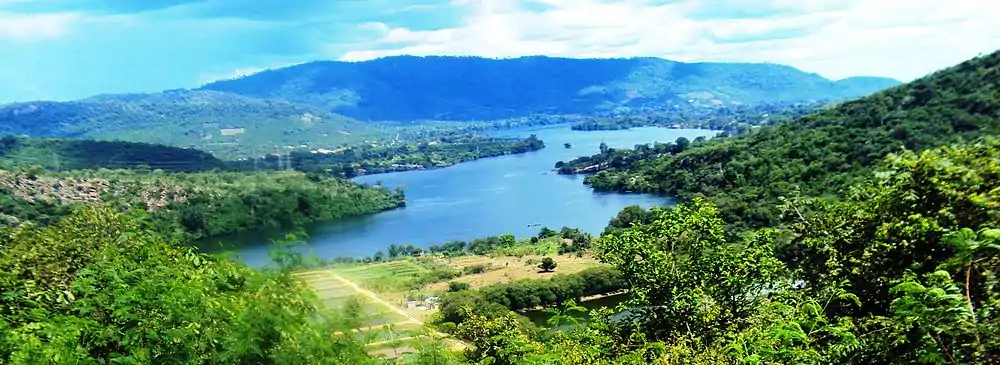Lake Volta
Lake Volta, the largest artificial reservoir in the world based on surface area, is contained behind the Akosombo Dam which generates a substantial amount of Ghana's electricity. It is completely within the country of Ghana and has a surface area of 8,502 square kilometres (3,283 sq mi; 2,101,000 acres). It extends from Akosombo in the south to the northern part of the country.[1][2]
| Lake Volta | |
|---|---|
 | |
 Lake Volta | |
 Lake Volta in Ghana | |
| Location | Ghana, West Africa |
| Coordinates | 6°30′N 0°0′E |
| Lake type | Reservoir |
| Primary inflows | White Volta River Black Volta River |
| Primary outflows | Volta River |
| Catchment area | 385,180 km2 (148,720 sq mi) |
| Basin countries | Ghana |
| Surface area | 8,502 km2 (3,283 sq mi) |
| Average depth | 18.8 m (62 ft) |
| Max. depth | 75 m (246 ft) |
| Water volume | 148 km3 (32.6 × 1012 gallons) |
| Shore length1 | 4,800 kilometres (2,980 mi) |
| Surface elevation | 85 m (279 ft) |
| 1 Shore length is not a well-defined measure. | |
Geography
Lake Volta lies along the Prime meridian, and just six degrees of latitude north of the Equator. The lake's northernmost point is close to the town of Yapei, and its southernmost extreme is at the Akosombo Dam, 520 km (320 mi) downstream from Yapei. Akosombo Dam holds back both the White Volta River and the Black Volta River, which formerly converged where the middle of the reservoir now lies, to form the single Volta River. The present Volta River flows from the outlets of the dam's powerhouse and spillways to the Atlantic Ocean in southern Ghana.
The main islands within the lake are Dodi, Dwarf, and Kporve.[3] Digya National Park lies on part of the lake's western shore.
History
The lake is formed by the Akosombo Dam, which was originally conceived by the geologist Albert Ernest Kitson in 1915, but whose construction only began in 1961 with completion in 1965. Because of the formation of Lake Volta, about 78,000 people were relocated[4] to new towns and villages, along with 200,000 animals belonging to them. About 120 buildings were destroyed, not including small residences, as over 3,000 square miles (7,800 km2) of territory were flooded.
Economy
The Akosombo Dam provides electricity for much of the country, as well as for export to Togo, Benin, and nearby countries, to earn foreign exchange. Lake Volta is also important for transportation, providing a waterway for both ferries and cargo watercraft. Since the huge lake lies in a tropical area, the water remains warm year-round naturally. Given good management, Lake Volta is the location of a vast population of fish and large fisheries.
The lake also attracts tourism, and tourist cruises visit the island of Dodi.[3]
Recent developments include a large-scale enterprise to harvest submerged timber from the flooded forests under Lake Volta. This project harvests high-value tropical hardwood without requiring additional logging or destruction of existing forest and, according to Wayne Dunn, "could generate the largest source of environmentally sustainable natural tropical hardwood in the world."[5] The Ghanaian-owned company Underwater Forest Resources has committed itself to making said lumber available in the global market, while Flooring Solutions Ghana have become the suppliers of hardwood floors, using the rare wood from the Lake. In addition to generating foreign currency for the region and reducing the dependence of locals on fishing as a primary economic activity, the removal of submerged trees is improving navigation on the lake and increasing safety.[5]
An estimated 7,000 to 10,000 children work in the fishing industry on Lake Volta. The nature of their employment has been described as slavery in The Guardian[6] and by the CNN Freedom Project. This has been described as sensationalism by Betty Mensah and the academic Samuel Okyere since many of the children and youth whose wages are given upfront to their parents grow up to become self-sufficient fishermen in adulthood who in turn hire children themselves and could therefore also be characterized as apprentices. They conclude, that many children may suffer under exploitative work but are not enslaved.[7]
Photos
 A ferry on Lake Volta.
A ferry on Lake Volta. Photograph of Lake Volta.
Photograph of Lake Volta. Akosombo Port's signage.
Akosombo Port's signage. Trees in Lake Volta.
Trees in Lake Volta._Dock_%E2%88%92_Lake_Volta.jpg.webp)
See also
- Lake Kariba, the world's largest reservoir by volume
References
- "Lake Volta, Ghana". Visible Earth. NASA. Retrieved 7 March 2018.
- "Largest, Tallest, Biggest, Shortest". McqsPoint. McqsPoint. Retrieved 9 February 2018.
- "Dodi Island cruises". secureserver.net. Archived from the original on 2010-10-31.
- https://www.britannica.com/place/Lake-Volta
- "Harvesting an Underwater Forest". Archived from the original on March 4, 2012. Retrieved 28 May 2011.CS1 maint: unfit URL (link)
- "Sons for Sale". www.theguardian.com.
- Okyere, Samuel (18 March 2019). "How CNN reported on 'child slaves' who were not really enslaved". AlJazeera. Retrieved 30 July 2019.
External links
| Wikimedia Commons has media related to Lake Volta. |
- Lake Volta & Akosombo on Ghanaweb.com
- Volta Lake, International Lake Environment Committee Web site
- Gold exploration in the Volta region — Objective Capital Africa Resources Investment Conference (video)
- Lake Volta — more information on Ghana-Net.com
